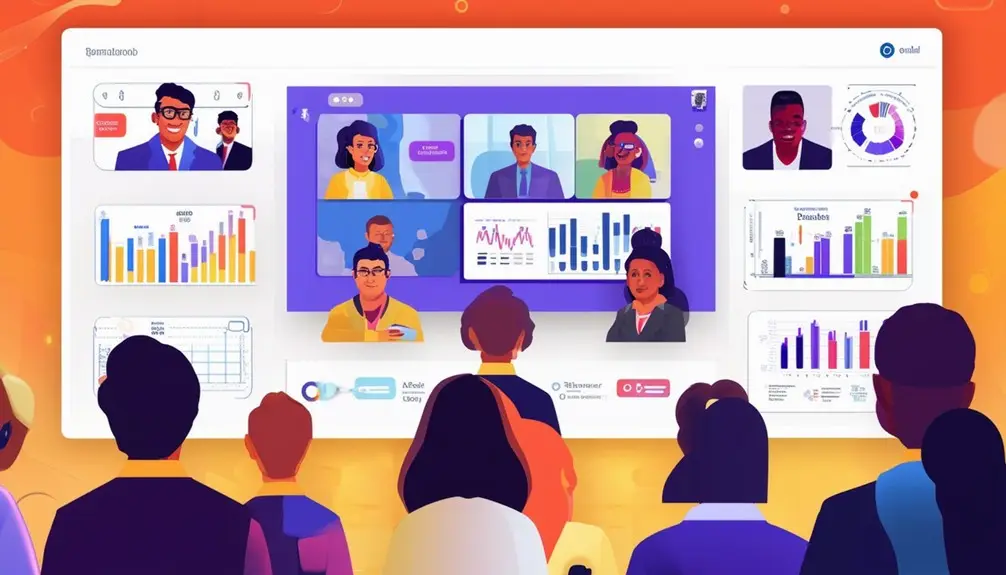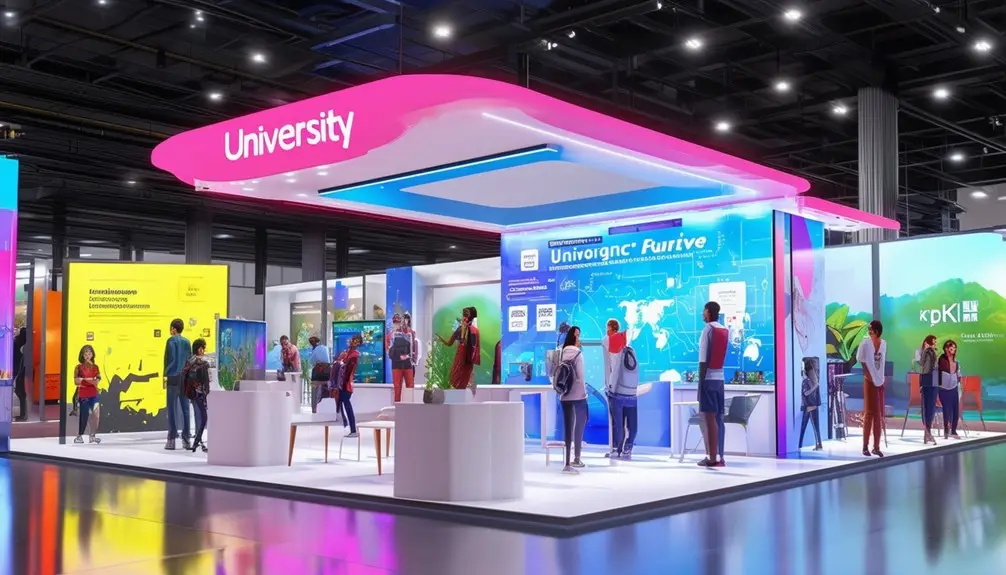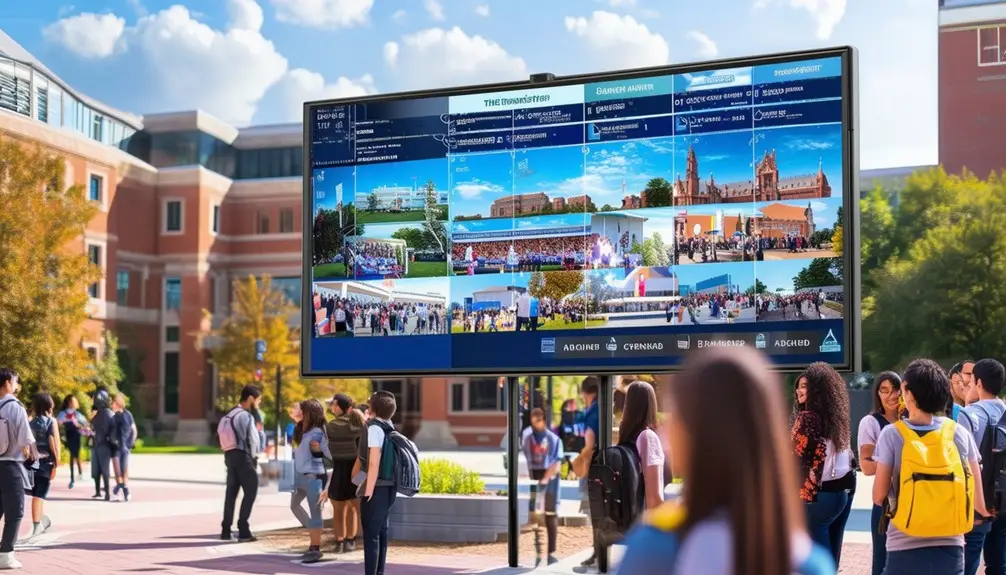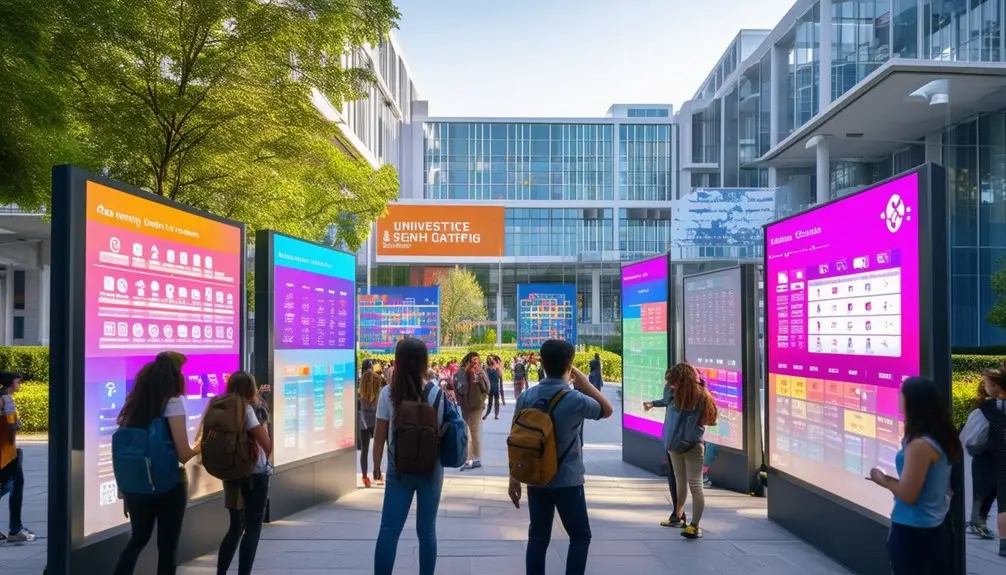Interactive event boards can transform campus activities by enhancing engagement with real-time updates, schedules, maps, and announcements. These boards seamlessly support both physical and virtual events, making them versatile for any occasion. They’re invaluable for gathering feedback and data, helping improve future events. In classrooms, interactive boards boost collaboration and participation, fostering dynamic learning. For virtual conferences and career fairs, these boards offer engaging features like virtual booths and breakout rooms, creating immersive networking opportunities. They’re also perfect for virtual exhibitions, providing interactive elements to explore campus life. Discover how these tools can elevate your university experience.
Key Takeaways
- Interactive event boards enhance student engagement with real-time updates, schedules, and maps for campus events.
- They support seamless integration of physical and virtual university events, enhancing accessibility and participation.
- Event boards gather valuable feedback and data, improving future university events and student experiences.
- Interactive platforms foster active student collaboration, enhancing comprehension through shared whiteboards and interactive models.
- Virtual booths and AI chatbots in event boards facilitate deeper connections during university career fairs and open days.
Benefits of Interactive Event Boards

Interactive event boards significantly enhance attendee engagement and interaction at university events. By incorporating these boards into your events, you create a dynamic platform for sharing information and promoting activities. For universities, this means providing students, faculty, and guests with real-time updates, schedules, maps, and announcements, all accessible in a user-friendly manner.
With the rise of virtual events in higher education, interactive event boards are more crucial than ever. They not only support physical gatherings but also seamlessly integrate into virtual settings. Features like touchscreens, QR code scanning, and multimedia content make it easy for attendees to navigate the event’s offerings, regardless of whether they’re on-campus or attending remotely.
Interactive event boards allow universities to gather valuable feedback and data. By analyzing attendee behavior and preferences, you can fine-tune future events to better meet your community’s needs. This data-driven approach guarantees that each event is more successful than the last.
Incorporating interactive event boards into your university events isn’t just a trend; it’s a strategic move to foster greater engagement and interaction, ensuring that your events are both informative and memorable.
Virtual Classroom Integration
Virtual classroom integration can enhance student collaboration through shared whiteboards, screen-sharing, and interactive 3D models. These immersive tools boost engagement and participation, making the learning experience more dynamic and effective. By leveraging live-streaming and interactive features, you foster an environment that promotes active learning and better knowledge retention.
Enhancing Student Collaboration
By integrating virtual classroom tools like shared whiteboards and 3D models, universities can boost student collaboration and engagement to a large extent. These tools offer an interactive platform where students can actively participate in discussions, collaborate on projects, and engage in campus events. Virtual classroom environments facilitate student collaboration by allowing real-time interaction through features like screen-sharing, which helps in sharing ideas and resources seamlessly.
Utilizing shared whiteboards, students can brainstorm and work together on complex problems, creating a sense of community even in a virtual setting. The inclusion of 3D models enables students to visualize and manipulate objects, making abstract concepts more tangible and easier to understand. Laser pointers and other interactive tools further enhance the learning experience by allowing students to highlight important aspects during presentations.
Live-streaming capabilities in virtual classrooms also play a significant role in increasing student involvement. These tools make it possible to host virtual campus events that can be attended by a wider audience, fostering a more inclusive educational environment. By leveraging these advanced features, universities can create dynamic and engaging learning experiences that promote active participation and collaboration among students.
Immersive Learning Tools
Utilizing immersive learning tools in virtual classrooms can greatly improve the educational experience by promoting deeper student engagement and understanding. When you integrate technologies like shared whiteboards, screen-sharing, and 3D models, you create an environment where students can actively participate and collaborate. These interactive tools transform traditional learning into immersive learning experiences that keep students engaged and motivated.
In a virtual classroom, you can use roleplays, 3D models, and laser pointers to make lessons more dynamic and interactive. These tools allow students to visualize complex concepts and collaborate on projects in real-time. For instance, a shared whiteboard can facilitate brainstorming sessions, while screen-sharing enables live demonstrations. Such features not only enhance student involvement but also improve comprehension and retention.
Live-streaming tools further boost student interaction by enabling real-time questions and discussions. This immediate feedback loop helps clarify doubts and fosters a more interactive learning atmosphere. By leveraging these immersive learning tools, you can create a virtual classroom that mirrors the engagement and effectiveness of traditional in-person teaching, thereby enriching the educational experience significantly.
Enhancing Virtual Conferences

Interactive event boards greatly enhance the quality of virtual conferences by offering engaging features like virtual auditoriums and breakout rooms. These interactive event boards transform a virtual conference into an immersive experience, facilitating engaging presentations and discussions. By leveraging these platforms, you can host sessions in virtual auditoriums that mimic the feel of in-person events, creating a more dynamic environment for attendees.
Breakout rooms enable smaller, focused group discussions, ensuring that participants can network and exchange ideas effectively. Additionally, interactive exhibit halls allow attendees to explore various booths, interact with exhibitors, and gather information in a more personalized manner.
Attendees can engage directly with speakers and other participants through live chats and Q&A sessions, making the virtual conference feel more interactive and inclusive. You can also customize the event boards to reflect your university’s branding and theme, enhancing the overall experience and ensuring it aligns with your objectives.
Data analytics and tracking tools provide valuable insights into attendee interactions and engagement levels. These tools help you measure the success of your event and identify areas for improvement, ensuring each subsequent virtual conference is even more impactful.
Features for Career Fairs
For career fairs, interactive event boards offer virtual booths where recruiters can engage directly with students through private audio zones. You’ll find that these virtual booths are a hub of activity, allowing students to submit resumes, participate in role-plays, and explore job opportunities in a realistic virtual environment. Recruiters can make use of interactive tools like 3D models, laser pointers, and presentations to attract and connect with potential candidates effectively.
Utilizing these interactive tools, recruiters can create an engaging and dynamic experience. Features like shared whiteboards and screen-sharing enable detailed discussions and presentations, making it easier for recruiters to showcase their companies and available positions. Interactive presentations can also provide a thorough overview of what the company offers, enhancing students’ understanding and interest.
Career fairs that leverage interactive event boards greatly enhance networking opportunities. These platforms facilitate meaningful connections between students and companies, providing an efficient and effective way for talent acquisition. By creating an immersive and interactive environment, interactive event boards bridge the gap between traditional career fairs and modern virtual experiences, ensuring that both recruiters and students can maximize their networking potential.
Engaging Virtual Exhibitions

Engaging virtual exhibitions enhances student engagement by offering interactive booths with AI chatbots and faculty members. These immersive experiences allow prospective students to explore campus life comfortably and safely. By leveraging these interactive elements, your institution can create memorable first interactions that set you apart.
Enhancing Student Engagement
Virtual event boards transform student engagement by offering immersive exhibitions that let you explore campus life in a dynamic, interactive way. Imagine attending a virtual open day where you can walk through digital replicas of the campus, interact with faculty members, and dive deep into academic programs—all from the comfort of your home. These interactive boards make it possible to experience campus life without stepping foot on the actual grounds.
Universities are increasingly using features like AI chatbots and 3D models to create a more realistic and engaging environment. With these tools, you can ask questions in real-time, explore detailed 3D renderings of facilities, and even participate in live Q&A sessions with current students and staff. It’s a seamless way to gain a thorough understanding of what the university has to offer.
Leveraging Interactive Booths
Interactive booths in virtual exhibitions offer prospective students a unique and engaging way to connect with universities on a personal level. By integrating features such as AI chatbots and live interactions with faculty members, these virtual events create dynamic and interactive experiences. Prospective students can gain valuable insights into campus life, academic programs, and extracurricular activities from the comfort of their own homes.
Utilizing interactive booths during virtual open days allows your institution to stand out. These booths provide a platform for personalized interactions, making prospective students feel valued and understood. By incorporating technology, you can simulate face-to-face conversations, answer specific queries in real-time, and even offer virtual campus tours.
Creating relationships from the first interaction is essential. Interactive booths enable you to establish a connection with prospective students early on, building trust and interest. The safe and comfortable environment of virtual events helps students explore your institution without the pressure of physical presence.
Case Studies and Success Stories

MootUp’s immersive technology has revolutionized events for organizations like TEDxLeuven, the United Nations, and the Association of African American Financial Advisors. TEDxLeuven successfully hosted its first 3D immersive virtual event, offering attendees an engaging and interactive experience. This breakthrough demonstrates the potential of virtual career events for universities, where students can explore career opportunities in a dynamic virtual environment.
The United Nations marked its 75th Anniversary with MootUp’s web-based technology, making the celebration memorable and accessible to a global audience. Universities can adopt similar strategies for large-scale events, ensuring inclusivity and wide reach. By integrating interactive learning tools like shared whiteboards, screen-sharing, and 3D models, virtual classrooms become more engaging and effective.
The Association of African American Financial Advisors Annual Event utilized MootUp for immersive networking experiences, highlighting the platform’s potential for fostering meaningful connections. Universities can leverage these capabilities to host virtual fairs, enabling prospective students to connect with institutions effortlessly. These case studies underscore the transformative power of immersive technology in enhancing event experiences, making them more interactive and impactful. By adopting such technologies, universities can stay ahead in offering innovative and engaging virtual events.
Conclusion
In embracing interactive event boards, you’re not just adopting technology; you’re planting seeds for a thriving, connected campus. These boards symbolize the bridges linking virtual classrooms, dynamic conferences, and engaging career fairs. They’re the lighthouses guiding students toward opportunities and innovations. By integrating these tools, you’re fostering an ecosystem where every event is a step toward greater unity and success. So, let these boards be the beacons of your university’s bright future.
Frequently Asked Questions
How Can Universities Ensure the Security and Privacy of Data on Interactive Event Boards?
You can safeguard data security and privacy by implementing strong encryption, regularly updating software, using secure login methods, and conducting periodic security audits. Educate users on best practices to minimize potential risks and vulnerabilities.
What Technical Support Is Available for Troubleshooting Issues With the Event Board Platform?
You can access technical support through a dedicated helpdesk, online chat, and detailed user manuals. They’ll assist with troubleshooting issues, ensuring your event board platform operates smoothly and efficiently. Don’t hesitate to reach out.
Are Interactive Event Boards Customizable to Match the University’s Branding?
Yes, you can customize interactive event boards to match your university’s branding. You can adjust colors, logos, and layouts to align with your institution’s visual identity, ensuring a cohesive and professional appearance.
How Accessible Are Interactive Event Boards for Students With Disabilities?
You should make sure interactive event boards are highly accessible for students with disabilities. Look for features like screen readers, high-contrast options, and touchless navigation. These enhancements promote inclusivity and guarantee everyone can access the information.
Can Interactive Event Boards Integrate With Existing University Systems and Software?
Sure, you can integrate these tools with your university systems and software. They sync seamlessly, enhance efficiency, and streamline operations. You’ll find it easy to manage events, communicate, and keep information up-to-date.





